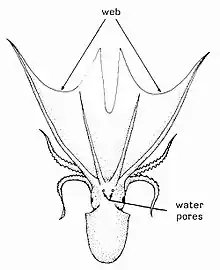Cephalopod beak
All extant cephalopods have a two-part beak, or rostrum, situated in the buccal mass and surrounded by the muscular head appendages. The dorsal (upper) mandible fits into the ventral (lower) mandible and together they function in a scissor-like fashion.[1][2] The beak may also be referred to as the mandibles or jaws.[3]
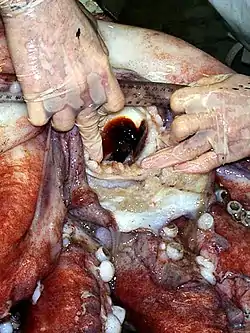
Fossilised remains of beaks are known from a number of cephalopod groups, both extant and extinct, including squids, octopuses, belemnites, and vampyromorphs.[3][4][5][6][7][8][9] Aptychi – paired plate-like structures found in ammonites – may also have been jaw elements.[10][11][12][13]
Composition
Composed primarily of chitin and cross-linked proteins,[14][15][16][17] beaks are more-or-less indigestible and are often the only identifiable cephalopod remains found in the stomachs of predatory species such as sperm whales.[18] Cephalopod beaks gradually become less stiff as one moves from the tip to the base, a gradient that results from differing chemical composition. In hydrated beaks of the Humboldt squid (Dosidicus gigas) this stiffness gradient spans two orders of magnitude.[19]
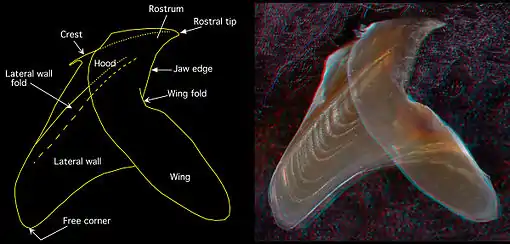 Side view of the lower beak of Chiroteuthis picteti (3.6 mm LRL, 160 mm ML (estimate))[1]
Side view of the lower beak of Chiroteuthis picteti (3.6 mm LRL, 160 mm ML (estimate))[1] 3D red cyan glasses are recommended to view this image correctly.
3D red cyan glasses are recommended to view this image correctly.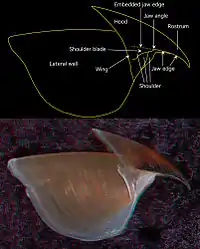 Side view of the upper beak from the same specimen (2.7 mm URL)[1]
Side view of the upper beak from the same specimen (2.7 mm URL)[1]
Measurements
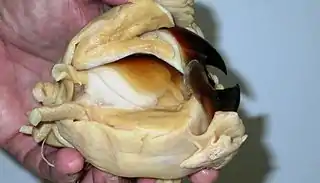
The abbreviations LRL and URL are commonly used in teuthology to refer to lower rostral length and upper rostral length, respectively. These are the standard measures of beak size in Decapodiformes; hood length is preferred for Octopodiformes.[18] They can be used to estimate the mantle length and total body weight of the original animal as well as the total ingested biomass of the species.[20][21][22][23][24][25][26]
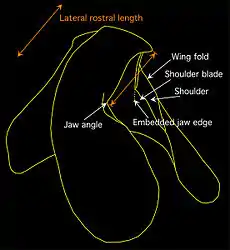 Lower rostral length
Lower rostral length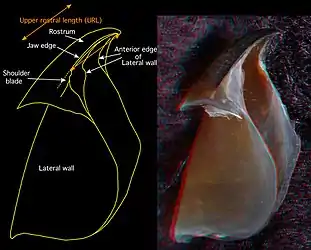 Upper rostral length
Upper rostral length
References
- Young, R.E., M. Vecchione & K.M. Mangold (1999). Cephalopoda Glossary. Tree of Life Web Project.
- Young, R.E., M. Vecchione & K.M. Mangold (2000). Cephalopod Beak Terminology. Tree of Life Web Project.
- Tanabe, K., Y. Hikida & Y. Iba (2006). Two coleoid jaws from the Upper Cretaceous of Hokkaido, Japan. Journal of Paleontology 80(1): 138–145. doi:10.1666/0022-3360(2006)080[0138:TCJFTU]2.0.CO;2
- Zakharov, Y.D. & T.A. Lominadze (1983). New data on the jaw apparatus of fossil cephalopods. Lethaia 16(1): 67–78. doi:10.1111/j.1502-3931.1983.tb02000.x
- Kanie, Y. (1998). New vampyromorph (Coleoidea: Cephalopoda) jaw apparatuses from the Late Cretaceous of Japan. Bulletin of Gumma Museum of Natural History 2: 23–34.
- Tanabe, K. & N.H. Landman (2002). Morphological diversity of the jaws of Cretaceous Ammonoidea. Abhandlungen der Geologischen Bundesanstalt, Wien 57: 157–165.
- Tanabe, K., P. Trask, R. Ross & Y. Hikida (2008). Late Cretaceous octobrachiate coleoid lower jaws from the north Pacific regions. Journal of Paleontology 82(2): 398–408. doi:10.1666/07-029.1
- Klug, C., G. Schweigert, D. Fuchs & G. Dietl (2010). First record of a belemnite preserved with beaks, arms and ink sac from the Nusplingen Lithographic Limestone (Kimmeridgian, SW Germany). Lethaia 43(4): 445–456. doi:10.1111/j.1502-3931.2009.00203.x
- Tanabe, K. (2012). Comparative morphology of modern and fossil coleoid jaw apparatuses. Neues Jahrbuch für Geologie und Paläontologie, Abhandlungen 266(1): 9–18. doi:10.1127/0077-7749/2012/0243
- Morton, N. (1981). Aptychi: the myth of the ammonite operculum. Lethaia 14(1): 57–61. doi:10.1111/j.1502-3931.1981.tb01074.x
- Morton, N. & M. Nixon (1987). Size and function of ammonite aptychi in comparison with buccal masses of modem cephalopods. Lethaia 20(3): 231–238. doi:10.1111/j.1502-3931.1987.tb02043.x
- Lehmann, U. & C. Kulicki (1990). Double function of aptychi (Ammonoidea) as jaw elements and opercula. Lethaia 23: 325–331. doi:10.1111/j.1502-3931.1990.tb01365.x
- Seilacher, A. (1993). Ammonite aptychi; how to transform a jaw into an operculum? American Journal of Science 293: 20–32. doi:10.2475/ajs.293.A.20
- Saunders, W.B., C. Spinosa, C. Teichert & R.C. Banks (1978). "The jaw apparatus of Recent Nautilus and its palaeontological implications" (PDF). Archived from the original (PDF) on 2016-10-05. Retrieved 2016-09-12. Palaeontology 21(1): 129–141.
- Hunt, S. & M. Nixon (1981). A comparative study of protein composition in the chitin-protein complexes of the beak, pen, sucker disc, radula and oesophageal cuticle of cephalopods. Comparative Biochemistry and Physiology Part B: Comparative Biochemistry 68(4): 535–546. doi:10.1016/0305-0491(81)90071-7
- Miserez, A., Y. Li, J.H. Waite & F. Zok (2007). "Jumbo squid beaks: Inspiration for design of robust organic composites" (PDF). Archived from the original (PDF) on 2016-03-05. Retrieved 2012-01-08. Acta Biomaterialia 3(1): 139–149. doi:10.1016/j.actbio.2006.09.004
- Organic composite is exceptionally robust: jumbo squid Archived 2012-01-06 at the Wayback Machine. Ask Nature.
- Clarke, M.R. (1986). A Handbook for the Identification of Cephalopod Beaks. Oxford University Press, Oxford.
- Miserez, A., T. Schneberk, C. Sun, F.W. Zok & J.H. Waite (2008). The transition from stiff to compliant materials in squid beaks. Science 319(5871): 1816–1819. doi:10.1126/science.1154117
- Clarke, M.R. (1962). The identification of cephalopod "beaks" and the relationship between beak size and total body weight. Bulletin of the British Museum (Natural History), Zoology 8(10): 419–480.
- Wolff, G.A. (1981). "A beak key for eight eastern tropical Pacific cephalopod species with relationships between their beak dimensions and size" (PDF). Fishery Bulletin 80(2): 357–370.
- Wolff, G.A. (1984). "Identification and estimation of size from the beaks of 18 species of cephalopods from the Pacific Ocean" (PDF). Archived from the original (PDF) on 2016-03-04. Retrieved 2013-02-03. NOAA Technical Report NMFS 17, NOAA/National Marine Fisheries Service.
- Jackson, G.D. (1995). The use of beaks as tools for biomass estimation in the deepwater squid Moroteuthis ingens (Cephalopoda: Onychoteuthidae) in New Zealand waters. Polar Biology 15(1): 9–14. doi:10.1007/BF00236118
- Jackson, G.D. & J.F. McKinnon (1996). Beak length analysis of arrow squid Nototodarus sloanii (Cephalopoda: Ommastrephidae) in southern New Zealand waters. Polar Biology 16(3): 227–230. doi:10.1007/BF02329211
- Jackson, G.D., N.G. Buxton & M.J.A. George (1997). Beak length analysis of Moroteuthis ingens (Cephalopoda: Onychoteuthidae) from the Falkland Islands region of the Patagonian Shelf. Journal of the Marine Biological Association of the United Kingdom 77(4): 1235–1238. doi:10.1017/S0025315400038765
- Gröger, J., U. Piatkowski & H. Heinemann (2000). "Beak length analysis of the Southern Ocean squid Psychroteuthis glacialis (Cephalopoda: Psychroteuthidae) and its use for size and biomass estimation". Polar Biology 23(1): 70–74. doi:10.1007/s003000050009
Further reading
- Aldridge, A.E. (2009). Can beak shape help to research the life history of squid? New Zealand Journal of Marine and Freshwater Research 43(5): 1061–1067. doi:10.1080/00288330.2009.9626529
- Bolstad, K.S. (2006). Sexual dimorphism in the beaks of Moroteuthis ingens Smith, 1881 (Cephalopoda: Oegopsida: Onychoteuthidae). New Zealand Journal of Zoology 33(4): 317–327. doi:10.1080/03014223.2006.9518459
- Chen, X., H. Lu, B. Liu, Y. Chen, S. Li & M. Jin (2012). Species identification of Ommastrephes bartramii, Dosidicus gigas, Sthenoteuthis oualaniensis and Illex argentinus (Ommastrephidae) using beak morphological variables. Scientia Marina 76(3): 473–481.doi:10.3989/scimar.03408.05B
- Cherel, Y. & K.A. Hobson (2005). Stable isotopes, beaks and predators: a new tool to study the trophic ecology of cephalopods, including giant and colossal squids. Proceedings of the Royal Society B: Biological Sciences 272(1572): 1601–1607. doi:10.1098/rspb.2005.3115
- Clarke, M.R. & N. MacLeod (1974). Cephalopod remains from a sperm whale caught off Vigo, Spain. Journal of the Marine Biological Association of the United Kingdom 54(4): 959–968. doi:10.1017/S0025315400057684
- Clarke, M.R. & L. Maddock (1988). Beaks of living coleoid Cephalopoda. In: M.R. Clarke & E.R. Trueman (eds.) The Mollusca. Volume 12. Paleontology and Neontology of Cephalopods. Academic Press, San Diego. pp. 121–131.
- Clarke, M.R. & R.E. Young (1998). Description and analysis of cephalopod beaks from stomachs of six species of odontocete cetaceans stranded on Hawaiian shores. Journal of the Marine Biological Association of the United Kingdom 78(2): 623–641. doi:10.1017/S0025315400041667
- Hernańdez-García, V., U. Piatkowski & M.R. Clarke (1998). Development of the darkening of Todarodes sagittatus beaks and its relation to growth and reproduction. South African Journal of Marine Science 20(1): 363–373. doi:10.2989/025776198784126485
- Hernández-López, J.L. & J.J. Castro-Hernández (2001). "Age determined from the daily deposition of concentric rings on common octopus (Octopus vulgaris) beaks" (PDF). Archived from the original (PDF) on 2013-05-13. Fishery Bulletin 99(4): 679–684.
- Hobson, K.A. & Y. Cherel (2006). Isotopic reconstruction of marine food webs using cephalopod beaks: new insight from captively raised Sepia officinalis. Canadian Journal of Zoology 84(5): 766–770. doi:10.1139/z06-049
- Hsu, C.-C. (2002). Geomorphometric study of Octopus and Cistopus (Cephalopoda: Octopodidae) based on landmarks of beaks. Master's thesis, National Sun Yat-sen University, Kaohsiung, Taiwan.
- Ivanovic, M.L. & N.E. Brunetti (1997). Description of Illex argentinus beaks and rostral length relationships with size and weight of squids. Revista de Investigación y Desarrollo Pesquero 11: 135–144.
- Lalas, C. (2009). Estimates of size for the large octopus Macroctopus maorum from measures of beaks in prey remains. New Zealand Journal of Marine and Freshwater Research 43(2): 635–642. doi:10.1080/00288330909510029
- Lefkaditou E. & P. Bekas (2004). Analysis of beak morphometry of the horned octopus Eledone cirrhosa (Cephalopoda: Octopoda) in the Thracian Sea (NE Mediterranean). Mediterranean Marine Science 5(1): 143–149.
- Lu, C.C. & R. Ickeringill (2002). "Cephalopod beak identification and biomass estimation techniques: tools for dietary studies of southern Australian finfishes" (PDF). Archived from the original (PDF) on 2016-03-04. Retrieved 2013-04-07. Museum Victoria Science Reports 6: 1–65.
- Martínez, P., A. Sanjuan & Á. Guerra (2002). Identification of Illex coindetii, I. illecebrosus and I. argentinus (Cephalopoda: Ommastrephidae) throughout the Atlantic Ocean; by body and beak characters. Marine Biology 141(1): 131–143. doi:10.1007/s00227-002-0796-7
- Ogden, R.S., A.L. Allcock, P.C. Watts & J.P. Thorpe (1998). The role of beak shape in octopodid taxonomy. South African Journal of Marine Science 20(1): 29–36. doi:10.2989/025776198784126476
- Roeleveld, M.A.C. (2000). Giant squid beaks: implications for systematics. Journal of the Marine Biological Association of the UK 80(1): 185–187. doi:10.1017/S0025315499001769
- Uchikawa, K., M. Sakai, T. Wakabayashi & T. Ichii (2009). The relationship between paralarval feeding and morphological changes in the proboscis and beaks of the neon flying squid Ommastrephes bartramii. Fisheries Science 75(2): 317–323. doi:10.1007/s12562-008-0036-2
- Xavier, J.C., M.R. Clarke, M.C. Magalhães, G. Stowasser, C. Blanco & Y. Cherel (2007). "Current status of using beaks to identify cephalopods: III International Workshop and training course on cephalopod beaks, Faial Island, Azores, April 2007" (PDF). Archived from the original (PDF) on 2016-03-05. Retrieved 2013-04-07. Arquipélago: Life and Marine Sciences 24: 41–48.
- Xavier, J.C. & Y. Cherel (2009). "Cephalopod Beak Guide for the Southern Ocean" (PDF). British Antarctic Survey, Cambridge. 129 pp.
- Xavier, J.C., R.A. Phillips & Y. Cherel (2011). Cephalopods in marine predator diet assessments: why identifying upper and lower beaks is important. ICES Journal of Marine Science 68(9): 1857–1864. doi:10.1093/icesjms/fsr103
| Wikimedia Commons has media related to Cephalopod beaks. |

